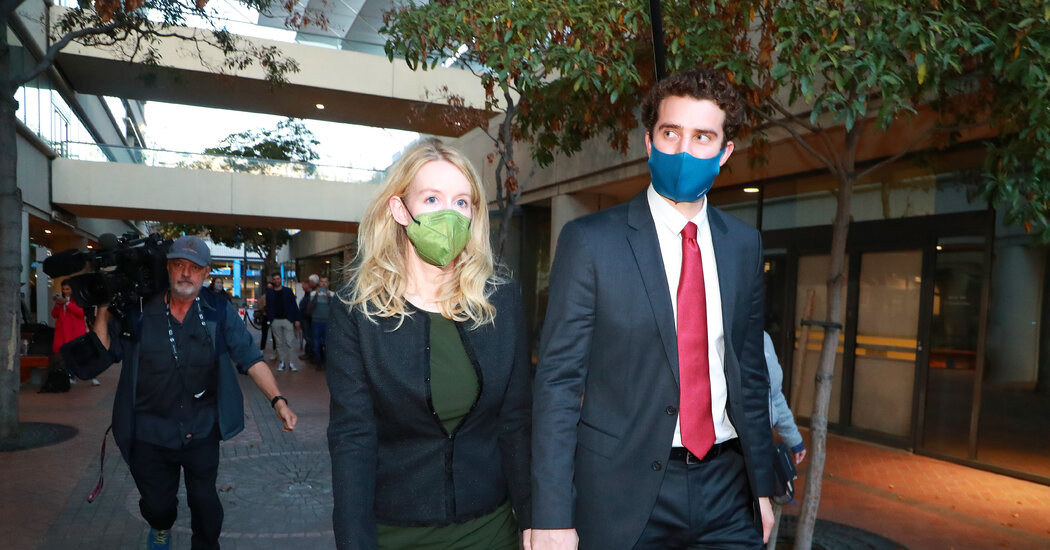
SAN JOSE, Calif. — Elizabeth Holmes, the founder of the failed blood testing start-up Theranos, took the stand for a fourth day on Monday to defend herself in a fraud trial that has been billed as a test of start-up hubris and hype.
Ms. Holmes faces 11 charges of defrauding patients, doctors and investors by lying to them about Theranos’s technology and business relationships. She has pleaded not guilty.
Before Theranos collapsed, it was a Silicon Valley darling that promised to revolutionize health care through cheaper, simpler blood tests that took only a few drops of blood. Ms. Holmes raised nearly $1 billion from investors and was heralded as the next Steve Jobs. But a 2015 investigation from The Wall Street Journal revealed that Theranos’s blood-testing technology did not work, and the start-up unraveled.
In the first 11 weeks of Ms. Holmes’s trial, prosecutors called 29 witnesses. They testified that Ms. Holmes and Theranos had falsified reports, concealed the use of third-party blood testing devices, faked technology demonstrations and exaggerated the company’s marketing claims.
To rebut those arguments, Ms. Holmes, 37, took the stand on Nov. 19. In her first few days of testimony, she blamed others, said she was a true believer of Theranos’s technology and posited that her decisions were misunderstood. Kevin Downey, Ms. Holmes’s lawyer, has painted his client as a well-meaning entrepreneur whose actions to protect her company were twisted by prosecutors as fraud.
Here’s what has happened in Ms. Holmes’s testimony:
Faked Validation Reports
A key moment in the trial happened on the third day of Ms. Holmes’s testimony, when she said that she had personally added pharmaceutical company logos to Theranos reports, which were then used to persuade investors and partners to work with her start-up.
Prosecutors have held up the reports as evidence that Ms. Holmes lied about Theranos’s prospects. The reports bore the logos of the drug makers Pfizer and Schering-Plough, even though neither company had a hand in preparing or approving the reports and both recommended against using Theranos’s technology.
In her testimony, Ms. Holmes said she added the drug makers’ logos to the reports “because this work was done in partnership with those companies and I was trying to convey that.” She argued that she had not intended to deceive anyone and would have done things differently if she had known that investors and partners would view the logos as endorsements by the drug makers.
Deflecting Blame
Ms. Holmes has spent much of her testimony arguing that others at Theranos were responsible for the company’s shortcomings.
She said that Adam Rosendorff, Theranos’s lab director, was responsible for the clinical lab, and that a vice president, Daniel Young, was in charge of a partnership with the pharmacy chain Walgreens. She also highlighted the experience of her star-studded board of directors, implying that they should have given her better counsel.
Ms. Holmes’s understanding of Theranos’s technology was that “it performed well,” she said.
When Mr. Downey brought up a study done by scientists at Johns Hopkins University that concluded that Theranos’s technology was “novel and sound,” Ms. Holmes said, “Our team was really excited about this. This was some of the best laboratory experts in the world.”
Establishing Intent
To convict Ms. Holmes, the prosecution needs to prove that she intended to commit fraud. On the stand, Ms. Holmes has consistently said that she did not intend to deceive anyone.
She said that she concealed Theranos’s use of third-party devices — one of the prosecution’s major allegations against her — because she was worried others would copy modifications that Theranos had made to those devices. She also said her intent was not to hide that Theranos’s own machines could not do as many tests as she claimed.
“This was an invention that we understood from our counsel we had to protect as a trade secret,” Ms. Holmes said.
She added that Theranos’s marketing claims were aimed at establishing the start-up’s brand separate from that of its bigger partners. Ms. Holmes said she made those claims on the advice of the prominent advertising agency TBWA\Chiat\Day and did not approve any materials she thought were inaccurate.
On Monday, Ms. Holmes said she had “absolutely not” told Theranos’s lab personnel to hide anything about the start-up during a 2013 inspection by regulators.



